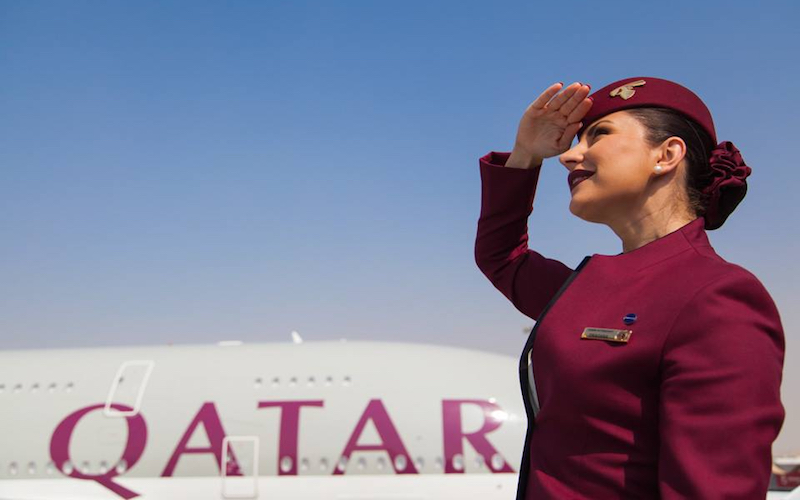
The GCC Crisis and Qatar Airways
The ongoing Qatar crisis has posed a series of dilemmas for the tiny Arabian emirate. With three fellow Gulf Cooperation Council (GCC) states – Bahrain, Saudi Arabia, the United Arab Emirates (UAE) – and Egypt, collectively known as the quartet, having imposed land, air, and sea blockades on Qatar, officials in Doha had to make major adjustments to keep their country solvent, sovereign, and open for business with the outside world. It is worth asking, what this row in the GCC means for one of Qatar’s largest economic players, Qatar Airways.
Saudi Arabia cut off Qatar Airways’ rights to use its air space for flights and all flights to and from Qatar. This move forced Qatar to re-route over Turkey and Iran, pushing Doha closer to Tehran. Qatar Airways loses roughly 50 flights a day, 18 destinations, and approximately 18 percent of the “airlines total seating capacity,” said Rob Watts, managing director at Aerotask, a global aviation consultancy firm. “Profitable redeployment of this capacity will prove a substantial challenge for the airline.” In a recent report CAPA Centre for Aviation said, “The ban on flights has a greater impact on Qatar Airways, which operates more flights [on affected routes] than all other airlines combined.”
In reaction to the crisis, Qatar Airways added new flights to the Czech Republic, France, Macedonia, Oman, which will be implemented by the end of 2017. They also announced new services to Australia, Brazil, Chile, and the US for 2018. Qatar seems to be doubling down on new destinations to counteract the effects of losing a large portion of their Gulf flights.
In addition, to keep their planes busy Qatar Airways agreed to lease nine Airbus A320s and cabin crew to British Airways short haul summer routes between July 1 and July 16. Qatar Airways cargo planes are also being used to transport 4,000 cattle to Qatar from Australia, Hungary, and the US on 60 flights. Moutaz al-Khayyat, chairman of Power International Holding, took on the mission to start a farm and provide fresh milk to Qatar, which Saudi Arabia provided the emirate prior to June 5.
Qatar Airways seeks to purchase 10 percent stock, worth over $81 million, in American Airlines. The diplomatic shake up reminded Qatar that it needs a diversified portfolio and cannot rely on its GCC partners. US air travel accounts for 8 percent of Qatar Airways flights and with plans to expand over 20 percent by next year, Qatar airways does not seem to be fazed by the Saudi backlash. Dublin Reuters reported that American’s CEO Doug Parker recently told Qatar Airways CEO, Akbar al-Baker that he would not recommend the purchase to the board which must give approval for purchases over 4.75 percent. Al-Baker vowed that he would buy 4.75 percent with hopes the smaller purchase will prove Qatar Airways value, despite American Airlines’ decision to halt marketing agreements with them and Etihad on the 24th of March this year. When asked about further investments, possibly in Europe, Bloomberg reported that al-Baker said that “a general never lays down his battle plans in advance.” The rhetoric suggests Qatar that views diversification as a defensive move against the quartet.
Many GCC states learned that they need to diversify their economies in the wake of oil prices. Qatar Airways’ move to purchase stock in American Airlines may have been rushed due to the tiff with the coalition but this, or a similar move, was most likely on its way. Al-Baker told CNNMoney that the airline has seen a dip in reservations but the drop is “manageable.” The ban has largely been lifted but Emirates, Etihad, and Qatar Airways all saw a dip in bookings from the US electronics ban in the middle of Ramadan and peak booking season.
Despite its recent business ventures, Qatar Airways has a rocky relationship with the US airlines. The US continues to criticize the GCC airlines for creating unfair competition through their use of government subsidies. More recently, Qatar airways took a low blow at Delta Airlines to criticize the age of its flight attendants. After American Airlines intervened, al-Baker apologized for calling Delta’s crew “grandmothers.”
A few weeks prior Delta released a 15 minute long video for its employees detailing the unfair competition and government subsidies featuring members of the company. The video was not released on the company’s YouTube or official website but the agenda has its own website. Our Future Our Fight calls on Delta employees and their family and friends to lobby to Congress by tweeting the president and writing a letter to local congressmen to enforce the Open Skies Agreement and to keep the open skies fair. The Open Skies Agreement calls for “an international aviation system based on competition among airlines in the marketplace with minimum government interference and regulation.” The agreement explicitly does not mention that an airline cannot receive subsidies from the government.
In early July, Airbus announced Qatar Airways cancelled four A350s, or $1.2 billion in orders because of delivery delays. The move cost Airbus around $60-80 million in lush interiors that now have to be replaced for resale. Qatar cites too many delays in production on Airbus behalf but Airbus notes that the airline made frequent changes to plans and that the supply chain delays were known. The frequent changes could have been meant to delay production long enough for the economic move not be seen as a repercussion of the diplomatic fiasco. Reuters reported, “All the Gulf carriers realize they have ordered too many wide-bodied aircraft and don’t have room for them, especially now,” said an aircraft finance industry official on low oil prices, current crises, and US electronic ban polices. Al-Baker denies the Gulf quarrel interferes with Qatar Airways’ growth or aircraft deliveries.
Irrespective of Qatar’s positioning as to the impact of the quarrel; operationally the impact of a narrowed air-corridor is certain to cause economic grief. As the Washington Post noted “Qatar Airways is a giant, global airline. It has 197 aircraft, most of them geared for long-haul flights to more than 150 destinations from its hub in the Qatari capital, Doha. It is a key player in the Oneworld airline alliance that includes American Airlines. Those planes regularly traversed Saudi airspace, in particular, before the crisis. All flights to Africa, as well as the airline’s flight to Sao Paulo and onward to Buenos Aires, used Saudi airspace. Many more used the Emirati airspace that lies just to Qatar’s east, toward the rest of Asia and the Pacific.”
Now, the practical implication for Qatar is that it has to reroute its flights to fly around ‘restricted air-space’ being air-space it previously was permitted to fly-over (KSA and UAE inclusive).
Why is that a big deal? Airlines operate on thin-margins; with an industry fact that profits are generated by business and first-class seats, and economy making a contribution towards covering operating costs. The Partnership for Open & Fair Skies observed that Qatar Airlines had declared a $703 million operating loss for the fiscal year ended 2017; and that was after receiving nearly $500 million in subsidies. Further, “Airline Weekly noted in June 19, 2017…that Qatar Airline had the 4th worst performance in the entire global airline industry”[Emphasis of Open & Fair Skies].
The key issue here is that this lackluster financial performance occurred before the restriction of air-rights. And this restriction makes air-travel much much more expensive for Qatar Airline today.
How so? Civil Aviation Authorities tend to adopt similar if not identical requirements for their airlines mirroring international norms and protocols (principally to ensure that a local airline will be permitted access into another country’s air-space, and because insurance tends to enforce adoption of best standards in order to acquire competitive insurance rates for the airline on its assets).
A key norm relates to the observation of operating hours and related rest of air-crews. Once a flight exceeds the maximum permitted hours an aircrew can operate according to CAA regulations, a new air-crew is required. On direct flights from Los Angeles to Sydney for example, this would mean having a reserve air-crew on board who takes over from the initial aircrew midflight. Additional crews, more hotel rooms, possibly turn-around time being lengthened – all add up to additional cost.
A local example: Emirates is able to fly to Athens – and return using the same aircrew because total hours in the air are below the maximum permissible hours in operation. Qatar could do the same pre-blockage; but now, having to add just an additional forty-five minutes in the air, to ‘go-around’ KSA airspace and reroute over Turkey; the total hours to Athens there and back now exceed the maximum hours, and an additional aircrew is needed.
If Qatar Airlines was struggling to make operating profits before the blockage; now with most of its flights contained to the thin entry and exit corridor; with more time spent lingering in (expensive) Iranian air-space (as a QA flight is charged for entering the space), plus the fact of having to add more flight crews to its ‘local flights’ into Africa, it seems that QA is headed towards an even worse financial operating loss for the fiscal year ended 2018.
Like Emirates Airlines, QA is a significant contributor to the GDP of the country; like Emirates it’s duty-free and travel programmes were all part of a strategy to develop tourism, logistics and win a lion’s share of air-travel commuters. Unlike Emirates – it appears that QA’s strategy has not contributed towards generating operating profits and foreign exchange for Qatar, but in the last year it has in fact absorbed and utilized foreign exchange. Is this situation sustainable? Well that depends on the degree to which Qatar is willing to maintain a market presence while significant demands are made on its foreign exchange reserves.
Neither side seems to be backing down. In late June, the coalition presented a 13-point list of demands that include expelling Turkish military forces, severing relations with Iran, closing Al Jazeera, paying reparations, and agreeing to be frequently monitored for compliance. The demands were not met within the stipulated ten days and the KSA/UAE-led bloc is not exactly happy.
Qatar has seen some economic effects of the crises but it would seem that these are not as crippling as the coalition would like. Qatar Airways asserts that it made up for its lost flights with new ones, the government has created new business partners, and the two together have found new ways to supply its country with essentials like food.
The move by Saudi Arabia and the coalition may have been made to induce Qatar to step in line but it seems to have been proven that Qatar doesn’t need Saudi’s strong arm to survive. But appearances can be deceptive, and it may be too soon to know the real impact.

